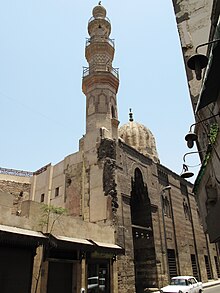Mosque and Khanqah of Shaykhu
| Mosque of Shaykhu | |
|---|---|

Mosque of Shaykhu
|
|
| Basic information | |
| Location | Cairo, Egypt |
| Affiliation | Islam |
| Architectural description | |
| Architectural type | Mosque |
| Architectural style | Mamluk |
| Date established | 1349 |
The Mosque and Khanqah of Shaykhu is an Islamic complex in Cairo built by the Grand Emir Sayf al-Din Shaykhu al-Nasiri. The mosque was built in 1349, while the khanqah was built in 1355. Shaykhu was the Grand Emir under the rule of Sultan an-Nasir Hasan.
Sayf al-Din Shaykhu al-Nasiri was the major political authority and one of the most celebrated amirs in the state of Sultan Hasan. The supervision of the state was in his control and he focused on policies leading to the stability of the nation and peace between the different groups of people living in the region. He enjoyed prestige and acquired an enormous fortune through his daily income of 200,000 dirhmans or 10,000 dinars.
He was assassinated in 1357 C.E. Bey, the amir Manjak vizier, one of the Sultan’s Mamluks attacked him with a sword while Shaykhu was sitting at the House of Justice. The people in the Cairo Citadel panicked, causing so much turmoil throughout the crowd that people were killed. Bey was seized in the Mausoleum of al-Nasir, outside of Cairo, by ten of the grand amirs in full armor. Bey confessed and took full responsibility. “He said: ‘I brought to Shaykhu a request for a transfer from salary to landed property, but he did not gratify my concern. That decision had an overpowering influence on my soul’” (Smith). He was imprisoned before his execution by being impaled and afterwards his corpse circulated through the streets. Shaykhu was not killed instantly by the attacked but never recovered and died on the night of Friday, the 16th day of Dhu al-Qa’da in 758 or 1357 C.E. He is buried in his own khanqah and supplied the funds so that the Qur’an would be perpetually read at his tomb.
Al-Maqrizi called this “mosque is one of the most sublime mosques in Egypt (smith).” It is located opposite the Khanqah. The foundation is said to have been built for Shaykh Akmal al-Din al-Rumi, who was the principal of twenty Sufis attached to it and was ultimately buried within the khanqah. The mosque has an unusual layout and instead of increasing wall thickness to maintain internal symmetry, as was the standard practice, the prayer hall has an irregular shape with walls that are not parallel. The walls shadow the layout of the surrounding streets and “this unconventional layout allows the mausoleum to communicate with the sanctuary through a window” (Cairo of the Mamluks) This window replaced the mausoleum’s mihrab. The courtyard of the mosque is the earliest extant in a riwaq mosque to be paved with polychrome marble. Most of the mosque’s original work has gone under restortation, however, the mihrab contains remains of the polychrome marble of the era. The lower segment of the mihrab displays eighteenth century Tunisian tiles. Maqrizi also made the claim that “no previous mosque and khanqah, in the area of Saliba, has thrived to this extent, nor was there ever created in the Bahri Mamluk state the equal to their pious endowments and the excellence of their incomes” (Smith).
...
Wikipedia
